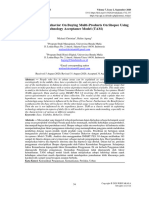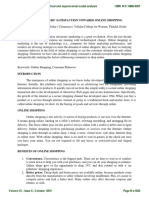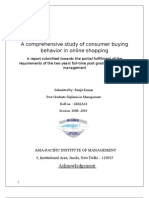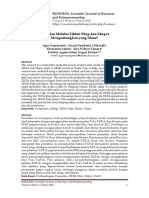JPIM Ganjil
JPIM Ganjil
Uploaded by
Nanda Juragan Sandal JepitCopyright:
Available Formats
JPIM Ganjil
JPIM Ganjil
Uploaded by
Nanda Juragan Sandal JepitOriginal Title
Copyright
Available Formats
Share this document
Did you find this document useful?
Is this content inappropriate?
Copyright:
Available Formats
JPIM Ganjil
JPIM Ganjil
Uploaded by
Nanda Juragan Sandal JepitCopyright:
Available Formats
Jurnal Penelitian Ekonomi dan Akuntansi (JPENSI)
http://jurnalekonomi.unisla.ac.id/index.php/jpensi
e-ISSN 2621-3168
p-ISSN 2502 – 3764
The Effect of After Sales Service on Online Shop Consumer
Satisfaction (Survey of Tokopedia and Shopee Consumers at
Kadiri University)
Nonni Yap1, Afif Nur Rahmadi2, Dian Ruhamak3, Risma Gesang Ayu4,
Anindhitya Sofi M5, Oktaviani Wahyu Prihardini6
1
Faculty of Economics, Kadiri University, nonni_yap@unik-kediri.ac.id
2
Faculty of Economics, Kadiri University, afifnur@unik-kediri.ac.id
3
Faculty of Economics, Kadiri University, dianruh@unik-kediri.ac.id
4
Faculty of Economics, Kadiri University, rismagesang@gmail.com
5
Faculty of Economics, Kadiri University, anindhityasofi@gmail.com
6
Faculty of Economics, Kadiri University, dinioktaviani261099@gmail.com
Keywords Abstract
Online shop, strategy, The platforms that are often used in this activity
platform, turnover, market are Tokopedia and Shopee, this is evident from
Tokopedia and Shopee being the two most
downloaded applications from the Google Play
Store. Some of the traders actually experienced
an increase in turnover by trading in online stores.
This is because online stores have a broad and
unlimited market.
INTRODUCTION
1. Background
The Covid-19 pandemic has had an impact on business activities,
especially retail traders, who used to be physically running their business
or seen opening shops and displaying their goods, with the current Covid-
19 Pandemic, many traders are flocking to online stores. The platforms
that are often used in this activity are Tokopedia and Shopee, this is
evident from Tokopedia and Shopee, which are the two most downloaded
applications from the Google Play Store. Some of the traders actually
experienced an increase in turnover by trading in online stores. This is
because online stores have a broad and unlimitied market. However, there
is one thing that has attracted the attention of researchers, namely the
Volume .. No…, ……... 2020 1
Penulis 1, Penulis 2, et al Jurnal Penelitian Ekonomi dan Akuntansi (JPENSI)
http://jurnalekonomi.unisla.ac.id/index.php/jpensi
e-ISSN 2621-3168
p-ISSN 2502 – 3764
successful strategy of increasing turnover when trading in online stores.
Research on marketing strategies is always interesting to do from
year to year, because marketing strategies move dynamically following
market conditions. In this context, trade is carried out online, where sellers
and buyers do not see each other but can foster a sense of trust until a
transaction occurs. If we look at the buyer’s side, the buyer can only judge
the credibility of the seller from the reviews of buyers who have made a
purchase. The thing that can affect the satisfaction is the suitability of the
goods that appear visually in the online store with the goods sent. But
that’s not the only thing that matters. There is one other thing that is more
important, namely after-sales service. After-sales service includes service
activities after the sale transaction. In it there is a sales return service when
the buyer is not satisfied with the goods sent, the speed of response to
buyer questions and also the hospitality attitude shown by the seller to the
buyer. Researchers are interested in knowing the effect of after-sales
service on online store consumer satisfaction in the Kadiri University area.
The results of this study are expected to be a reference for begineners who
want to do business through online stores. The following is data on online
store competition in Indonesia from monthly site visitors per – Quater
2020 & 2021 :
Table 1.1 Online Store Competition in Indonesia
2020
Q1 Q2 Q3 Q4
Online Visitors Online Visitors Online Visitors Online Visitors
Store Store Store Store
Tokopedia 68.134.000 Tokopedia 72.234.000 Tokopedia 87.545.000 Tokopedia 94.232.000
Shopee 65.534.000 Shopee 70.667.000 Shopee 85.908.000 Shopee 93.442.000
Lazada 28.387.000 Lazada 30.345.000 Lazada 37.776.000 Lazada 41.110.000
Bukalapak 25.800.000 Bukalapak 29.725.000 Bukalapak 32.440.000 Bukalapak 35.878.000
Blibli 10.100.000 Blibli 15.857.000 Blibli 17.880.000 Blibli 19.890.000
2021
Q1 Q2 Q3 Q4
2 Volume .. No…, ……... 2020
Penulis 1, Penulis 2, et al Jurnal Penelitian Ekonomi dan Akuntansi (JPENSI)
http://jurnalekonomi.unisla.ac.id/index.php/jpensi
e-ISSN 2621-3168
p-ISSN 2502 – 3764
Online Visitors Online Visitors Online Visitors Online Visitors
Store Store Store Store
Tokopedia 118.573.000 Tokopedia 120.486.000 Tokopedia 123.639.000 Tokopedia 125.589.000
Shopee 116.909.000 Shopee 118.138.000 Shopee 120.889.000 Shopee 122.800.000
Lazada 30.800.000 Lazada 34.900.000 Lazada 36.882.000 Lazada 41.110.000
Bukalapak 28.445.000 Bukalapak 30.843.000 Bukalapak 35.332.000 Bukalapak 38.668.000
Blibli 25.110.000 Blibli 26.900.000 Blibli 29.880.000 Blibli 31.222.000
It can be seen from the data above in 2019 Q1 to Q4. Tokopedia and Shopee are
always first and second. Starting from the product ordered when the item
purchased is really real, and very good.
2. Problem Formulation
Does after-sales service affect online shop customer satisfaction ?
LITERATURE REVIEW
1. Quality of Service
According to Tjiptono & Chandra (2012) the term quality contains
various interpretations, because quality has a number of levels, universal
(same everywhere), cultural (depending on the cultural values system),
social (formed by individual social classes, in simple terms quality can be
interpreted as a product that is free of charge). Defects this manufacturing
based definition is not relevant for the service sector. Therefore, the
understanding of quality is then expanded to “fitness for use and
conformance to requirements”.
Parasuraman in Lupiyoadi (2013) says that service quality is how far
the difference between reality and customer expectations for the service
they receive. Service quality reflects the comparison between the level of
service delivered by the company compared to customer expectations.
Service quality is realized through meeting customer needs and desires as
well as the accuracy of its delivery in balancing or exceeding customer
expectations. According to Wyckof in (Tjiptono, 2014) service quality is
the level of excellence expected and control over these advantages to meet
Volume .. No…, ……... 2020 3
Penulis 1, Penulis 2, et al Jurnal Penelitian Ekonomi dan Akuntansi (JPENSI)
http://jurnalekonomi.unisla.ac.id/index.php/jpensi
e-ISSN 2621-3168
p-ISSN 2502 – 3764
customer desired. With words on the other hand, there are two main
factors that affect the quality of the expected service and perceived
service..
2. Product
Setiyaningrum (2015) states that a product is a collection of
physical, psychological, service, and symbolic attributes created to satisfy
customer needs and desires. There are three levels of products and services
that must be understood by marketers, namely the core values of
consumers that will answer the question of what the buyer actually buys
the actual product which includes features, design, quality level, brand
name and attractive packaging, and product. Additional, which includes
delivery and installments, after-sales service, guarantees, and anything that
is traded for the purpose of profiting from the creativity of a person,
marketing team, or company. According to Tjiptono (2015) conceptually a
product is a producer’s subjective understanding of something than can be
offered as an effort to achieve organizational goal through fulfilling
consumer needs and desires, in accordance with the competence and
capacity of the organization as well as market purchasing power. In
addition, the product can also be defined as consumer perceptions that are
described by the producer through the results of their production or
operations.
W.J. Stanton in Alma (2016) says “a product is a set of tangible
and intangible atributes, including packaging, color, price, manufacturer’s
and manufacturer’s and retailer, which the buyer may accept as offering
want satisfaction”. Which means that the product is a set of attributes, both
tangible and intangible, including color, price, the good name of the factory,
the good name of the store that sells it (retailer), and factory services and
retailer services, which are received by the buyer to satisfy his desires.
Kotler in Alma (2016) states“a product is anything that can be
offered to a market to satisfy a want or need. Product that are marketed
include physical goods, services, experience, events, persons, places,
properties, organizations, information, and ideas. Events. This means that
the product is anything that can be offered in the market to satisfy the needs
4 Volume .. No…, ……... 2020
Penulis 1, Penulis 2, et al Jurnal Penelitian Ekonomi dan Akuntansi (JPENSI)
http://jurnalekonomi.unisla.ac.id/index.php/jpensi
e-ISSN 2621-3168
p-ISSN 2502 – 3764
and wants of consumers. Products consist of goods, services, experiences,
place, ownership, organization, information and ideas.
3. Price
According to Alma (2016) price is the value of an item expressed in
money. (Kotler & Keller, 2009) states that prices are not just numbers
labeled with prices. Prices take many forms and perform many functions.
Tuition rent, fees, wages, interest, fees, storage fees, salaries and
commissions are all prices paid for goods and services.
According to Utami (2017) price adjustments can be made by
retailers by setting a mark down. Mark down is a reduction of the initial
retail price, with the premise that a lower price is expected to increase the
number of sales. Some of the reasons for carrying out mark downs are
warehouse cleaning or promotions. Retailers have traditionally created a
set of rules that are free to accept mark downs. The limitations of the
approach can be explained as follows:
a. Treats all units in one product category with the same consistent
behavior
b. Follow a regular schedule
4. Buying Interest
Kotler & Keller (2009) state that consumer buying interest is a
consumer behavior where consumers have a desire to choose, use, and
consume or even want a product offered. It can be concluded that
consumer buying interest is an intention that arises from within a person to
make a purchase of a product or service with consideration before the
buying process takes place. The indicators of buying interest according to
Ferdinand (in Veronika, 2016:24), are:
a. Transactional interest
b. Referral interest
c. Preferential interest
d. exploratory interest
Volume .. No…, ……... 2020 5
Penulis 1, Penulis 2, et al Jurnal Penelitian Ekonomi dan Akuntansi (JPENSI)
http://jurnalekonomi.unisla.ac.id/index.php/jpensi
e-ISSN 2621-3168
p-ISSN 2502 – 3764
RESEARCH METHODS
RESULTS AND DISCUSSION
Overall, the findings in this study are in accordance with the results of
research that proves that e-service quality has a positive and significant effect on
satisfaction, the results of research that prove that customer satisfaction has a
positive effect on customer trust. Research by Darsono and Dharmmesta (2005),
Zboja and Voorhees (2006), Bouhlel et al. (2009), and Ha et al. (2010) prove that
customer trust has an effect on repurchase intention.
The results showed that service quality affects repurchase intention with
multiple mediation starting from customer satisfaction and brand trust. Service
quality is a determinant of customer satisfaction, trust, and repurchase intentions.
The higher the quality of service, the more satisfied customers, their trust and
repurchase intentions will be stronger, therefore online shops need to always
maintain and improve service quality, service satisfaction to maintain trust and
increase their customers' repurchase intentions. Customer satisfaction is
maintained from pre-purchase, and post-purchase.
For pre-purchases, the Website/Application should provide complete
information, this information can be in the form of information about product
specifications, various products, promotions, and payment systems. The online
shop must provide services in the form of a means to answer customer questions
quickly. When consumer questions can be answered quickly they feel well served
so they can be satisfied with the service.
When an online shop must have a site / application that makes it easy for
customers when shopping. The level of personalization on the site / application is
made according to consumer expectations so that consumers are satisfied, for that
it is important to know what consumers want and make personalization according
to consumer expectations.
CONCLUSIONS AND RECOMMENDATIONS
The results of this study indicate that service quality has a positive and
significant effect on customer satisfaction. Thus, the better the quality of online
services provided by the online shop, the higher the perceived satisfaction. The
results of the study also show that trust brand has a positive and significant effect
6 Volume .. No…, ……... 2020
Penulis 1, Penulis 2, et al Jurnal Penelitian Ekonomi dan Akuntansi (JPENSI)
http://jurnalekonomi.unisla.ac.id/index.php/jpensi
e-ISSN 2621-3168
p-ISSN 2502 – 3764
on repurchase intention. Thus, the higher the level of consumer confidence in the
online store, the greater the consumer's repurchase intention.
Based on the results of this study, it can be shown that service quality
affects repurchase intentions with multiple mediations ranging from customer
satisfaction and brand trust. Service quality is a determinant of customer
satisfaction, trust and repurchase intention. The better the quality of service
provided by the online shop, the more satisfied customers will be, and the more
trust they will have in their repurchase intention to make purchases at the online
shop.
Thus, to survive and even win the competition in the online market, every
online store must guarantee the quality of service, satisfaction and customer trust
to be able to encourage or strengthen their customers' repurchase intentions.
BIBLIOGRAPHY
Choudhary AI, Akhter SA, Asif M, Choudhry RM, Siddique Z, Mughal. (2011).
Impact Of After Sales Service Characteristics on Customer Satisfaction.
Information Management and Business Review, Vol 3, pp:360-365.
Egonsson E., Bayarsaikhan K dan Ting T. (2013). After sales services and
customer relationship marketing-A multiple case study within the Swedish
heavy equipment machinery Industry. Tesis. Linneaus University.
Ernoputri, D., Arifin, Z., & Fanani, D. (2016) Effect of after-sales service on
consumer satisfaction (a survey of LG product users in Malang Town
Square (Matos) Malang – East Java). Journal of Business Administration,
30 (1).
Fazizadeh A., Bagherzadh F dan Mohamdi P. (2011). How After Sales Service
Quality Dimension Affect Customer Satisfaction. African Journal of
Bussiness Management, Vol 5(17), pp:7658-7664.
Kotler, P. and Keller K.L. (2012). Marketing Management Edition 12 Volume 1.
PT. Gramedia Pustaka Utama. Jakarta.
Kurniawan A and Wardoyo P. (2011). Analysis of the Satisfaction Level of
Caterpillar Brand Heavy Equipment Users on After-Sales Service in Central
Java. Diponegoro University Research Journal. Semarang.
Volume .. No…, ……... 2020 7
Penulis 1, Penulis 2, et al Jurnal Penelitian Ekonomi dan Akuntansi (JPENSI)
http://jurnalekonomi.unisla.ac.id/index.php/jpensi
e-ISSN 2621-3168
p-ISSN 2502 – 3764
Mishra, A.K. (2014). A Study on Relation Between Effective After Sales Service
and Customer Overall Satisfaction at Tata Motor’s with Spesial Reference
to Ramgarhia Automobiles Ramgarh Cantt, Jharkhand. International
Journal of Research in Bussines Management, Vol 2 pp:79-88.
Pramana, Andy Chandra. 2013. The Effect of Billing System Service Quality on
User Satisfaction in Nganjuk Hospital. Journal. Student Scientific Journal of
FEB Universitas Brawijaya Vol.1, No. 1.
Sangadji and Sophia. (2013). Consumer Behavior-A Practical Approach
Accompanied by the Association of Research Journals. Edition I. CV Andi.
Yogyakarta.
Sarjono, Haryadi. 2011. SPSS vs LISREL: An Introduction, Application to
Research. Jakarta: Four Salemba.
8 Volume .. No…, ……... 2020
You might also like
- COPC CX Standard For OSPs Rel. 6.0a English PDFDocument99 pagesCOPC CX Standard For OSPs Rel. 6.0a English PDFvpreity67% (3)
- CIPS Level 4 - Diploma in Procurement and Supply Module 1 - Scope and Influence of Procurement and SupplyDocument4 pagesCIPS Level 4 - Diploma in Procurement and Supply Module 1 - Scope and Influence of Procurement and SupplyJalal Quteineh100% (1)
- AjioDocument91 pagesAjioTasmay Enterprises0% (2)
- Iqa Training SlidesDocument126 pagesIqa Training SlidesAnkur100% (6)
- SAP Business Workflow Introduction - BIT600Document58 pagesSAP Business Workflow Introduction - BIT600Kalpana Kadam100% (2)
- Siebel UCMDocument159 pagesSiebel UCMstephenraj_siebel100% (2)
- The Influence of Online Customer Reviews and E-Service Quality On Buying Decisions in Electronic CommerceDocument16 pagesThe Influence of Online Customer Reviews and E-Service Quality On Buying Decisions in Electronic CommerceThèn XưnNo ratings yet
- 189-Article Text-522-1-10-20210810Document7 pages189-Article Text-522-1-10-20210810Second Home CateringNo ratings yet
- The Effect of Promotion, Price, and Brand Image On Purchase Decisions On E-Commerce Shopee in Pangkalpinang CityDocument16 pagesThe Effect of Promotion, Price, and Brand Image On Purchase Decisions On E-Commerce Shopee in Pangkalpinang Citynv vernandoNo ratings yet
- Marketing Research Term Paper SiddiqDocument21 pagesMarketing Research Term Paper Siddiqএ.বি.এস. আশিকNo ratings yet
- Analisis Penawaran Pasar Dan Kualitas We 96b83ba1Document14 pagesAnalisis Penawaran Pasar Dan Kualitas We 96b83ba1Wuri PutriNo ratings yet
- Ijdns 2021 75Document8 pagesIjdns 2021 75Claudia NavedaNo ratings yet
- Jurnal Keputusan PembelinDocument16 pagesJurnal Keputusan PembelinsyahrulcimolNo ratings yet
- Urban Consumer Behavior - Halim AgungDocument7 pagesUrban Consumer Behavior - Halim Agungjulius stNo ratings yet
- From Clicks To Consequences: A Multi Method Review of Online Grocery ShoppingDocument40 pagesFrom Clicks To Consequences: A Multi Method Review of Online Grocery ShoppingCarolina Zúñiga BlancoNo ratings yet
- RESEARCH METHODOLOGY (1)Document27 pagesRESEARCH METHODOLOGY (1)Nguyễn Phan Tiểu MyNo ratings yet
- Comparison Analysis of Online Shop Between Lazada and Shopee IndonesiaDocument10 pagesComparison Analysis of Online Shop Between Lazada and Shopee Indonesiaginnlee1011No ratings yet
- Marketing Research Report Group 1 Ib LjdivbDocument15 pagesMarketing Research Report Group 1 Ib LjdivbParv PandyaNo ratings yet
- Antecedents of Customer Loyalty_ Study from the Indonesia's Largest E-commerceDocument11 pagesAntecedents of Customer Loyalty_ Study from the Indonesia's Largest E-commerceindraadiawarman99No ratings yet
- Pemfis NifasDocument12 pagesPemfis NifasDita shaliaNo ratings yet
- 2016-Article Text-10820-2-10-20220708Document12 pages2016-Article Text-10820-2-10-20220708Yuyun FebriantiiNo ratings yet
- Project Report On FilpkartDocument45 pagesProject Report On FilpkartAbhishek VishwakarmaNo ratings yet
- A Conceptual Study On The Impact of Online Shopping Towards Retailers and Consumers KavyaDocument5 pagesA Conceptual Study On The Impact of Online Shopping Towards Retailers and Consumers KavyaMehakNo ratings yet
- Ecommerce Boon and Its EffectsDocument7 pagesEcommerce Boon and Its Effectssunildm9135No ratings yet
- Jurnal Administrasi Bisnis 170910202006Document29 pagesJurnal Administrasi Bisnis 170910202006ahmad abul a'laNo ratings yet
- Project On Big Bazaar On Shrinkage & CSDDocument74 pagesProject On Big Bazaar On Shrinkage & CSDShantanu Bhardwaj67% (3)
- EJMCM - Volume 7 - Issue 8 - Pages 5820-5828Document9 pagesEJMCM - Volume 7 - Issue 8 - Pages 5820-5828jɨɲ๛ SђubђNo ratings yet
- Consumers' Attitude Towards Online Shopping: Tiktok Platform Shops in The PhilippinesDocument58 pagesConsumers' Attitude Towards Online Shopping: Tiktok Platform Shops in The PhilippinesburlasahannahmaeNo ratings yet
- Project On E Commerce Applications by Shikha 2028100866 MBA-2Document43 pagesProject On E Commerce Applications by Shikha 2028100866 MBA-2Ashok poddarNo ratings yet
- Consumer BehaviourDocument38 pagesConsumer BehaviourNishu goelNo ratings yet
- Pengaruh Brand Ambassador Dan Korean Wave Terhadap Minat Belanja Online MelaluiDocument15 pagesPengaruh Brand Ambassador Dan Korean Wave Terhadap Minat Belanja Online MelaluiAfif AhmadNo ratings yet
- 179 October 2645Document7 pages179 October 2645AVISEK CHAUDHURINo ratings yet
- Upaya Pengembangan Dan Peran Sistem Informasi Manajemen Dalam E-Commerce ShopeeDocument12 pagesUpaya Pengembangan Dan Peran Sistem Informasi Manajemen Dalam E-Commerce ShopeelembayungcarNo ratings yet
- PDF CRM in Big BazaarDocument24 pagesPDF CRM in Big BazaarMuhammad TahirNo ratings yet
- 810-Article Text-2829-1-10-20230715Document8 pages810-Article Text-2829-1-10-20230715Claire Nicole TomasNo ratings yet
- Impact On MallsDocument6 pagesImpact On Mallsmanvi aminNo ratings yet
- Analisis Minat Pembelian OnlineDocument9 pagesAnalisis Minat Pembelian OnlineCie BuiNo ratings yet
- Analisis Pengaruh Pesan Kelangkaan Dan Live CommerceDocument12 pagesAnalisis Pengaruh Pesan Kelangkaan Dan Live Commercearjunasitorus183No ratings yet
- Research Project Report: "Research On The Influence of E-Commerce On Consumer Purchasing Behaviour."Document87 pagesResearch Project Report: "Research On The Influence of E-Commerce On Consumer Purchasing Behaviour."NIKHIL KUMARNo ratings yet
- Analysis of Indonesian Consumer Online Shopping Behavior During The Covid-19 Pandemic: A Shopee Case StudyDocument11 pagesAnalysis of Indonesian Consumer Online Shopping Behavior During The Covid-19 Pandemic: A Shopee Case StudySiti Sarah Zalikha Binti Umar BakiNo ratings yet
- Ecommerce ReportDocument53 pagesEcommerce ReportManiha KhanNo ratings yet
- Team AshtonDocument21 pagesTeam AshtonSanyamNo ratings yet
- 983-Article Text-4328-1-10-20210926Document11 pages983-Article Text-4328-1-10-20210926Muhammad FawaidurrohmanNo ratings yet
- Factors Influencing Online Buying Behavior A Case of Shopee Customer 2022Document13 pagesFactors Influencing Online Buying Behavior A Case of Shopee Customer 2022ntrangjullyNo ratings yet
- Analysis of The Effect of E-Service Quality, Website Quality, Mobile Application Quality On Customer Satisfaction (Case Study at Shopee and Tokopedia)Document11 pagesAnalysis of The Effect of E-Service Quality, Website Quality, Mobile Application Quality On Customer Satisfaction (Case Study at Shopee and Tokopedia)International Journal of Innovative Science and Research TechnologyNo ratings yet
- 1047-Article Text-7173-1-10-20240129Document9 pages1047-Article Text-7173-1-10-20240129Gumchyyy BubbleNo ratings yet
- Marketing Strategies of BewakoofDocument19 pagesMarketing Strategies of Bewakoofseema50% (2)
- 95-Article Text-416-2-10-20220724Document7 pages95-Article Text-416-2-10-20220724smurfspammeNo ratings yet
- Project-on-E-Commerce-Applications by Muskan GoyalDocument44 pagesProject-on-E-Commerce-Applications by Muskan GoyalMuskan GoyalNo ratings yet
- Final ReportDocument57 pagesFinal ReportRajumauryaNo ratings yet
- NepalDocument12 pagesNepalarihantNo ratings yet
- Pengaruh Kualitas Website, Kualitas Pelayanan, Dan Kepercayaan Pelanggan Terhadap Minat Beli Pelanggan Di Situs Belanja Online BukalapakDocument18 pagesPengaruh Kualitas Website, Kualitas Pelayanan, Dan Kepercayaan Pelanggan Terhadap Minat Beli Pelanggan Di Situs Belanja Online BukalapakTri Putra GaneshaNo ratings yet
- MarketingDocument15 pagesMarketinglaplap byNo ratings yet
- Anjum Perween - E-Commerce ProjectDocument52 pagesAnjum Perween - E-Commerce Projectmdshabbir3600No ratings yet
- Analysis Marketing Strategy of TaobaoDocument5 pagesAnalysis Marketing Strategy of Taobaoylexcel.limNo ratings yet
- Wa0006.Document26 pagesWa0006.Hemsuta S.BNo ratings yet
- Customers Satisfaction Towards Online Shopping With Special Reference To Varanasi CityDocument64 pagesCustomers Satisfaction Towards Online Shopping With Special Reference To Varanasi City9415697349No ratings yet
- Winter ProjectDocument73 pagesWinter Projectranjitkumar828No ratings yet
- Gauri Gathe ProjectDocument67 pagesGauri Gathe Projectbuccspan2022No ratings yet
- Fulltexttttt 2Document60 pagesFulltexttttt 2TomásNo ratings yet
- Tanushree Shukla 7.0Document71 pagesTanushree Shukla 7.0studymaterial8170No ratings yet
- 1 +business+1-16Document16 pages1 +business+1-16AinunnNo ratings yet
- AdayroiDocument11 pagesAdayroithuylinhduong2612No ratings yet
- Strategic Management - Unit 1-1Document82 pagesStrategic Management - Unit 1-1Mitali BaldawaNo ratings yet
- Module 6 - IAS 2 Inventory SlidesDocument58 pagesModule 6 - IAS 2 Inventory SlidesGiven RefilweNo ratings yet
- RajnigandhaDocument11 pagesRajnigandhaShivam KashyapNo ratings yet
- Digital Marketing Proposal for _d'Alba'' in Malaysia.Document19 pagesDigital Marketing Proposal for _d'Alba'' in Malaysia.snsmarketing2.0No ratings yet
- Balanced ScorecardDocument38 pagesBalanced ScorecardJuliana ChavezNo ratings yet
- Packaged Material Handling EquipmentDocument12 pagesPackaged Material Handling EquipmentSajid Yasin100% (1)
- Lean ManagementDocument4 pagesLean ManagementkushiNo ratings yet
- GF-304CR Dossier.Document35 pagesGF-304CR Dossier.suria qaqcNo ratings yet
- BA 302 Lesson 4Document15 pagesBA 302 Lesson 4ピザンメルビンNo ratings yet
- Business Continuity Management SopDocument21 pagesBusiness Continuity Management SopPappuNo ratings yet
- Simulation of A Sustainable Cement Supply Chain Proposal Model ReviewDocument9 pagesSimulation of A Sustainable Cement Supply Chain Proposal Model Reviewbinaym tarikuNo ratings yet
- Lecture Notes: Theory of MarketsDocument24 pagesLecture Notes: Theory of MarketsAdruffNo ratings yet
- Abh Mar 140319 509PM Ac201903024Document34 pagesAbh Mar 140319 509PM Ac201903024Jeni BanikNo ratings yet
- Consumer Behaviour Towards Online ShoppingDocument49 pagesConsumer Behaviour Towards Online Shoppingpranav2411No ratings yet
- DIGITAL MARKETING Brochure - GreatmindscommDocument8 pagesDIGITAL MARKETING Brochure - GreatmindscommRayNo ratings yet
- Folio PrintingDocument13 pagesFolio PrintingGIHA BINTI TARDAN (KKSA)No ratings yet
- Unit-3 (Pom)Document141 pagesUnit-3 (Pom)atishayjain6939No ratings yet
- CIO and MckinseyDocument16 pagesCIO and Mckinseyramjet175% (4)
- HACO HistoryDocument10 pagesHACO Historycaca444No ratings yet
- Game 1 - Supply Chain Beer Game PlaysheetDocument17 pagesGame 1 - Supply Chain Beer Game PlaysheetNhi LuuNo ratings yet
- Supplier Relationship Management (SRM) Software From SAPDocument4 pagesSupplier Relationship Management (SRM) Software From SAPravi12feb90No ratings yet
- Pulp Strategy Advertising Agency: By: Tanya B HardwajDocument12 pagesPulp Strategy Advertising Agency: By: Tanya B HardwajTanya ChauhanNo ratings yet
- Audit Report (EN) Berehiv - 2021Document12 pagesAudit Report (EN) Berehiv - 2021Vladimir SenyukNo ratings yet
- Jysk Target: Jeffrey Alex, Rosanna Vermeulen, Sean Murray, Jacob Mather, Joseph BerkvensDocument16 pagesJysk Target: Jeffrey Alex, Rosanna Vermeulen, Sean Murray, Jacob Mather, Joseph Berkvenslightknight91No ratings yet
- Managerial Accounting: Chapter 2: Job Order Costing - Calculating Unit Product CostsDocument5 pagesManagerial Accounting: Chapter 2: Job Order Costing - Calculating Unit Product CostsBogdan MorosanNo ratings yet

























































































